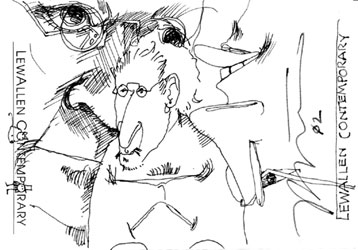|
“The masks continued to fall away, the thrust of the work kept evolving until, one evening in my studio, I realized that I could draw motion—a single figure in action. This coincided with some Native American myths that I was reading, and my old nemesis, the crow, took on a new twist. We became one while remaining two. Through the research to learn carving, I was bombarded with mythic images. Then the drawings began to transform rapidly into split figures, two faces creating one, man and animal sharing bodies, symbols with numerous applications.”
Excerpt from artist statement “Transformations” Rick Bartow 1989
“Contemporary art set me free,…It allowed me to have a lineage and create a statement that’s real – I can express something about my heritage, which is minimal, but nonetheless a part of me I can embrace with much more sympathy than that part of me that’s a part of the family of man that blew up Nagasaki.”
Rick Bartow, 1988 in “Man behind the Mask” by Dough Marx, Oregon Magazine
I cannot explain the urge to create. I usually apologize for it as it robs me of normalcy. I’m uncomfortable with it as it’s a bit like living in front of a mirror. I’m uncomfortable without it as I’m nothing without my mirror. I live in a theatre of the absurd where action is everything in a play without a script…..
Excerpt from “Tears and Rain” Rick Bartow, 2006
|

4 x selbst ( self ), drawing 2002
|